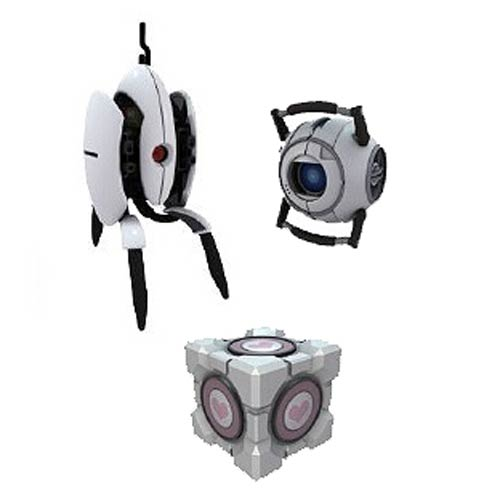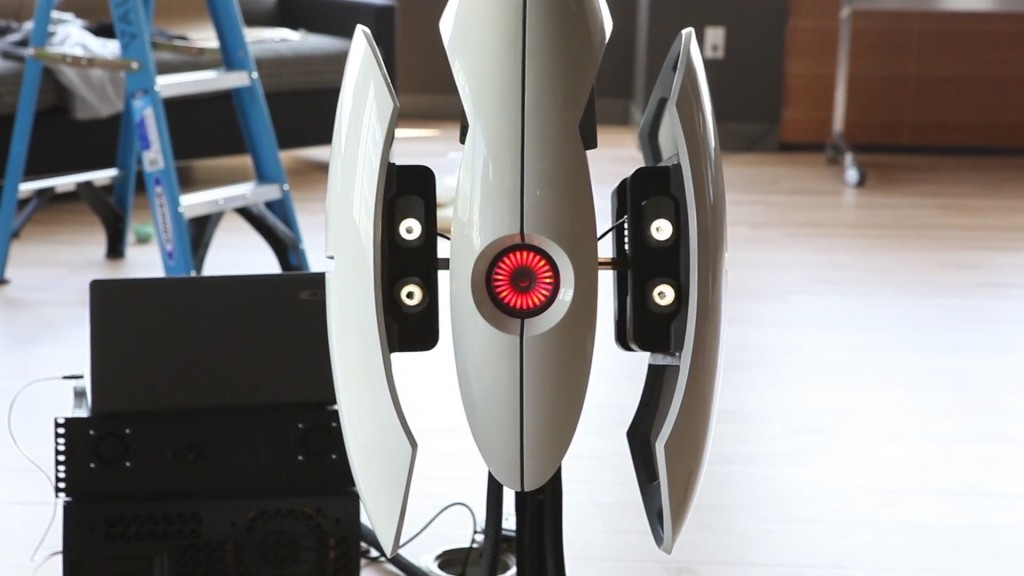
The 4th 'tendril' will fold over to attach to the rest of the piece. See the face I drew an "L" on? This will be the point of connection to the body later (and thus be obscured). The tabs here will connect as indicated (photo #2). Starting with the front left leg, you'll notice piece "U" has three "tendril" like pieces coming off of one side.

Pieces "U" & "V" (in red) will form the front left leg, pieces "W" & "X" (in blue) will form the front right leg, and pieces "Y" & "Z" (in green) will form the sole rear leg (photo #1). There are three separate sets for this step, one set per leg. The point of connection for each leg is still small however (especially for the rear leg), so you're really going to want to take your time on these pieces so they come out strong. Since this was impractical to duplicate with paper, the front legs will attach to the front of the body instead. In the game, the entire body is suspended from one point in the rear the front legs are connected to this point via looping rods. The legs are a bit trickier than most other pieces. Repeat the above steps for pieces "M" thru "P". There are no exact markings to position the barrels onto "Q", just use your best judgment. Repeat for "T".īoth of these will attach to the side of piece "Q", with the barrel with the smaller dot on top (photo #6). The large circle with the black dot in the center can then be folded down like a lid (photo #5). Starting with "S", attach the single large tab to its opposite end, forming a cylinder. "S" and "T" each make a separate silver gun barrel. Notice that this will cover up your labeling (if you chose to label the doors in the previous setp). The combined “Q” and “R” can now be attached to the “RIGHT” door (photo #4). The "crooked" end will attach to the turret's body later on. The "straight" end attaches to piece "Q" center it as best you can. You'll notice on one side all the edges are straight, while on the opposite side the edges are not (photo #3). Piece "R" is even simpler the only connection that needs to be made will turn it into a loop. The one “angled” side will attach to the door, oriented as shown (photo #2). Starting with "Q" thru "T" (the right side), piece "Q" is basically just a flat cube. Pieces "M", "N", "O", & "P" (in red) will connect the left door, and pieces "Q", "R", "S", & "T" (in blue) will connect the right. The eight (8) pieces highlighted in red and blue (photo #1) will form the two arms attaching the doors to the turret's body. Wash, rinse, and repeat for the second door using pieces "I" thru "L" (photo #5). This spot will be covered by the door's arms later, so the hole and/or labeling will be concealed. I used the same space to label the door "LEFT" (photo #4) so I wouldn't get them mixed up (though honestly they're basically identical, so you probably wouldn't even notice it if they were backwards). If you have trouble at the end, you can poke a hole in the center of piece "H" to manipulate the tabs using a paperclip. Finishing the door can be tricky in the same way closing the body was in the previous step.


From here, pieces "G", "F", & "E" will attach to "H" just as they are laid out (photo #3). Starting with the left door, attach the skinny half of piece "H" to the wider half (photo #2). Pieces "E", "F", "G", & "H" (in red) will form the left door, and pieces "I", "J", "K", & "L" (in blue) will form the right door. The eight (8) pieces highlighted in red and blue (photo #1) will form two separate components. Setting aside the body for now, we'll start on the turret's doors.
#PORTAL TURRET BOX HOW TO#
* Only for those who already know how to use the program PePaKuRa while it is a very useful tool, I will not be explaining its use in this guide. > OPTIONAL - PePaKuRa model file (.PDO) attached below * > Paper (I would recommend 16-20lbs (60-75gsm) paper, i.e. > Your preference of cutting implement (i.e. > The 2-page template (PDF) attached below While I will do my best to guide you through the assembly, parts of this model can be difficult for beginners namely the legs, which are the smallest and most intricate part. PLEASE NOTE, you do not actually need any of these programs to assemble the template in this instructable. BACKGROUNDįor those curious, this model was designed using several pieces of software, including student versions of 3D Studio Max and AutoCAD for the mesh, GIMP for the model’s skin, and PePaKuRa Designer to “unfold” it into the final template. It’s the lovable Sentry Turret from the hit PC/Xbox/PS3 game, Portal! Since its original release on my deviantArt page some time ago, I've received a number of requests for help/tutorials with this model, and in the spirit of the Make It Real challenge, I've decided to write up a concise guide to that end.


 0 kommentar(er)
0 kommentar(er)
